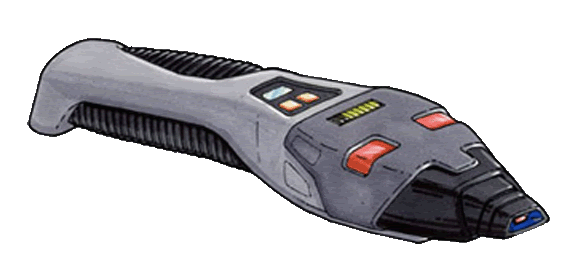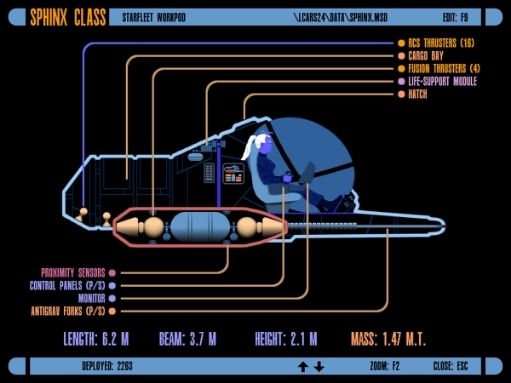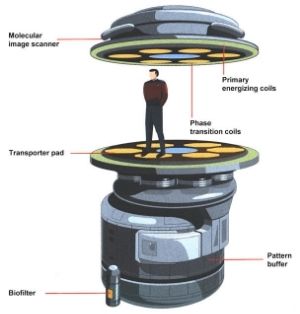 "Mutando Conservamus"
"Mutando Conservamus"
Entry #1 - Phasers part 1
Phasers, we all use them from time to time, if it is to stun your adversaries or to blow a piece of a wall away to escape from a burning room. Now, that might be an extreme example, but it is a good suggestion. Keep it in mind. What most officers and crewmen do not know is how these little hand held weapons work. The inner pieces of a Phaser and especially the type - II Phaser. An officer weapon of choice. Iconic battles have been fought with these weapons and so I thought it would be a good point to start. Think about it, how many times have you clutched the little weapon in your hand, thinking about how life was so short. Now how that is a macabre thought, it is the main weapon for us all. Our last line of defense is a crew member with a Phaser. Even if you have amazing disruptors and Quantum torpedoes on your ship. If it gets boarded, you only have your hands to fight with. Since many of us aren't the size of a Klingon, we have these weapons. Single handed Type - I Phasers are the most common. Yet, many officers have had training in Type 2.
Phaser types
Many Phaser types exist in this day and age. The most known to officers are:
- Type I - Single handed Phaser, backup to the common type 2.
- Type II - Standard issue single handed Phaser Pistol.
- Type III - Standard issue two handed Phaser Rifle.
Starting from this point, however, most Phasers will be ship or shuttle mounted. Think about the Phaser type - IV that is standard shuttle issue. we will leave that for another time.
The workings of a Phaser
The word Phaser is actually an acronym. The complete terminology is '
PHAsed
Energy
Rectification'. This coming from the way how it turns stored energy into an energy beam. Some of the scientists and engineers I spoke with use another acronym.
PHASEd array emitte
R. Both come down to the same weapon we have to come to know, yet perhaps not love. The basic workings are rather easy. Energetic plasma is send into a prefire chamber, this chamber is mostly made out of lithium-copper. This lithium-copper has been used, because it has superconducting features. After this transmission of energetic plasma into the prefire chamber, it undergoes a rapid Nadion effect. A Nadion is an artificially created particle, mostly used in Phasers and Disruptors.
This rapid Nadion effect of the Energetic plasma leads to a strong nuclear output, mostly nadion radiation. After this has occurred, a protonic charge is formed, which is being released into an emitter made out of the crystal, again, Lithium-Copper. In the before mentioned hand type (1, 2 and 3) Phasers the charge of energetic plasma is stored into Sarium-Krellide. See ti as an advanced battery. Except instead of 12 volts, this battery does quite a lot more. This material is also used, because it can not accidentally discharge its energy into the prefire chamber.
Some other parts of a Phaser.
Beam control Assembly: Put on the tip of most Phasers. This is simply used to control the output of the beam, its width, mostly.
Discharge Crystal: Before mentioned crystal at the middle of the Phaser, made out of Lithium-Copper. It is superconducting. Most of these crystals have an efficiency 90 percent these days, our Romulan allies have far greater technology on this. We do not understand why yet, but we at the Engineering corps are trying to understand.
Emission aperture: Again at the tip of the Phaser, just before the Beam Control Assembly. See it as a gateway to send harness the energy and lead it through the tip of the Phaser. Hence, creating a raw beam that will be controlled by the Beam Assembly.
Energy cell: A cell made out of Sarium-Krellide, used to store energy. If configured in the correct way it could be rechargeable.
Safety Interlock: Logically every Phaser has a safety mode, the safety interlock makes sure there is no accidental energy discharge into the Lithium-Copper discharge crystal. It can be switched on or off on the top of most Phasers.
Sight: Not easily spotted as it is linked to the operator. Many of these sights are used to make the operator able to shoot more accurate or see further in the distance. Easy and Accurate acquiring of a target is necessary in warfare.
"An artist depiction of the common Type II Phaser of recent years. Many officer will know this one."
Phaser Type I
The Type - I Phaser is most commonly carried by security and intelligence officers, in extreme cases diplomatic personnel. As with most Phasers, they are restricted to personnel that require usage of them on a daily basis. Yet, they are less common then the Type - II. The main reason for this is that they generally have slightly lesser power output. A Type - I has 8 settings, ranging from stun to heat and the ultimate setting, disintegration. While it is advised to be familiar with this type, it is an uncommon weapon for most officers.
The usage of the Type - I is mostly in cases that require a certain subterfuge. Think about concealment. As they capable of being fired by merely two fingers, they require next to no space. A pocket sized weapons, you could say. A favorite weapon among diplomats due to that reason. Even though they officially would not carry a weapon. As with most Phasers you are able to decide the beam width. This means you can create an energy output over a larger area, if needed, this however will take away from its strength.
Phaser Type - II
The Type - II Phaser is commonly stored in armories on board ships, stations and other facilities. All of you will have fired one in your career, even if it was just for training. It is still the size of a single handed weapon, but it has greater power output than the former Type - I. It has been standard issue since the 2260's, most likely being known for the countless times it has helped Admiral Kirk of the United Star Ship Enterprise. These weapons are the back bone of star fleet security. Yet, it is not only an offensive and defensive device. It can be used for cutting through certain metals, storing energy and if set to the correct settings it could be an explosive device.
This side arm has sixteen settings. A couple notable ones will follow.
Setting One - Light stun: Standard setting for a Phaser, when being stored always return the Phaser to this setting. It will be able to stun standard humanoids for about five minutes, depending on size of the body. The bane of ceramic enemies like pots. A certain Lieutenant Junior Grade Link was very fond of doing this during his academy days.
Setting Seven - Metallurgic usages: Able to disintegrate several alloys that most armor is made with, most notable Noranium carbide and other carbon based alloys.
Setting Ten - Kill setting: Starting with setting ten, we go into an area that is despised by many officers, yet necessary. This setting is the most used during extreme cases of aggression with life threatening outcomes. Most biological species will instantly stop living when hit by a Phaser on setting ten.
Setting Sixteen - Vaporization: The energy output of this setting is so great, that it can vaporize slight areas or personnel upon impact, complete disintegration of a body is possible, yet highly unadvised. It has been known to be used to create crevices in rocky environments.
As an added feature the Phaser can be set to a wider or narrower beam setting. As with the prior Type - I a wider Phaser beam will have less power upon impact, there for a setting 10 wide beam might only function as a setting 9 or in some cases setting 8. To compliment those features, the weapon can also be set to different frequencies. Creating a weapon capable of working better against some shields or our dreaded adversaries the Borg.
Phaser Type - III
The Type - III Phaser is carried by security officers or combatants whenever required. A MACO favorite, it is carried by Starfleet personnel around the galaxy. The federation insists however that this is an extreme measure. With an output of 3.4 x 10 to the 8 mega joule per power cell, this weapon packs a punch. Most of these rifle type Phasers are outfitted with twin hot-swappable power cells. It also had an extra customization, a split emitter resonator designed to tune the outgoing beam. It can create many effects. Single beam, burst fire or even simulate the array of an Earth Shotgun from the 21st century. It is a dangerous weapon.
If modified this weapon could fire focused beams combined with sight it would come close to the definition of a sniper weapons. Extreme power and extreme accuracy. Add a shoulder strap and you will become far more mobile with this weapon. Add an under barrel grip for more stability or if you are particularly vicious, use it as a bat.
A modification used these days is the compressed Phaser rifle. This gives far greater output then a normal Type - III. The weapon is not very different, yet the energy cells are improved and the crystal emitter efficiency is greatly improved.
Next issue
Everyone that put in their information on the Phaser is hereby thanked. We are always open for critique or further customization of the article. Again, this is merely what we know. If you think any information is incorrect, we invite you to send us a message through the holonet. Or speak to us personally. Thank you for your interest.
Commander Rix Brot'la
Engineering Department
Deep Space 13
Lieutenant Commander R.A.J. Kuiper
Commanding Officer of the U.S.S. Regal - Task Force Avalon
Attached to Starbase 381 - "Praetorian"
((Disclaimer: I have not come up with these things myself, this is a collection compiled of the notes that are found in canon sources. All of this is information is merely an In Character Summation of the information I found on certain subjects. I hope you will find it usefull))



